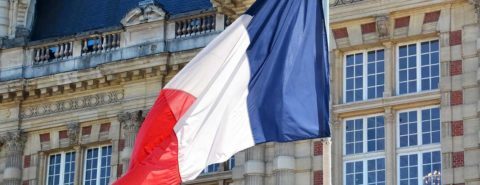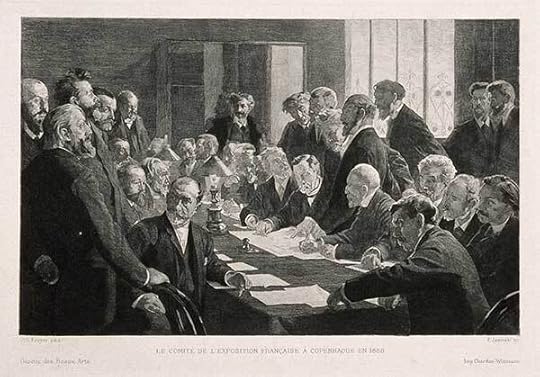Oxford University Press's Blog, page 74
July 11, 2022
Were you prepared for this pandemic?

Did you have a stock of fitted, unexpired N95 masks in your closet and a six-month supply of non-perishable foods in the pantry? Pretty much nobody was fully prepared, including me. Were you relying on the healthcare system to keep supplies on hand? In this case, the healthcare system was itself rapidly overwhelmed and close to collapse. Should we expect better preparedness from ourselves and our society?
“Way back” in 2003/4, with the SARS outbreak in Toronto, we were also surprised. We were not at all fully prepared for an outbreak of these proportions. Justice Archie Campbell, in his investigation of this, pointed out deficiencies in the system. These were not recommendations for treatment of patients. He made specific recommendations regarding systemic improvement. These improvements were only partially implemented, and the COVID-19 pandemic was as much a surprise in Ontario as it was elsewhere. His most important recommendation/suggestion/warning was that the precautionary principle was needed in future, in that “reasonable efforts to reduce risk need not await scientific proof.”
It may be that an expectation of full coordination, cooperation, communication, and logistical nimbleness is too much to ask of healthcare, public health, and societal systems that are not as much of an organized “system” as is believed. So, let’s leave that out of the discussion for now, and focus on the precautionary principle as the most important element of preparedness, as Campbell suggested.
In 2003 in Toronto, we were initially advised to take full airborne precautions; we wore N95 masks, with gowns and gloves. Why? Because the organism and the disease were totally unknown, and public health was taking few chances. What of the precautionary principle 19 years later? An article in Nature in April 2022 by D. Lewis pointed out several reasons why it took the World Health Organization (WHO) two years to declare that COVID-19 is airborne. A number of these reasons invoked a failure to use the precautionary principle. This required significant disregard for the WHO’s own documents and recommendations from two decades earlier. Ministers of both Health and Environment, for the Member States in the WHO European Region “way back” in 2004 declared: “We reaffirm the importance of the precautionary principle as a risk management tool, and we therefore recommend that it should be applied”. As well, another WHO publication from 2004 dealing entirely with the precautionary principle stated that, “If used intelligently, imaginatively and daringly, the precautionary principle will support efforts to strive towards a healthier and safer world”.
“At its simplest, the precautionary principle means that when there is serious risk, one should not wait for scientific confirmation before taking action.”
The precautionary principle had its origins in environmental protections in the 1970s. Although there is no universal definition, at its simplest, the precautionary principle means that when there is serious risk, one should not wait for scientific confirmation before taking action. There is a mistaken impression that the precautionary principle calls for jumping from the frying pan without scientific evidence of the characteristics of the fire. One may take action without waiting for scientific confirmation of the size of the fire, the number of BTUs produced, and the radius of the fire ring, if the frying pan is getting hot. Without full knowledge, there is indeed a risk of landing in the fire. However, if there is an estimate of the fire, then jumping may be a much safer alternative than waiting in the frying pan. The truth is that the precautionary principle is a clarion call for scientific evidence, as noted by Dr Martuzzi: “Thus, precaution requires more and better science.”
It seems reasonable to make preparations for catastrophe, if there is some evidence of impending catastrophe, even if the precise nature and extent of the catastrophe is not yet fully delineated. Should it turn out that there was no catastrophe, or that the risk was not great, “minimizers” look brilliant, having predicted the outcome correctly. As bets go, that would be a good bet—catastrophes are rare. In the process, they manage to fully protect the comfort of many people by minimizing danger and worry. More importantly, they also fully protect their budgets. A Forbes article in 2020, called the precautionary principle “Anti-Science” on the basis that it held up developments of medical advances whose releases were postponed, awaiting more scientific proof. This article, or its ilk, are worth consideration, but I do not agree that it is cause to outright reject the precautionary principle.
Should, in the end, there be no catastrophe, those who issued warnings using the precautionary principle will be assailed on the basis of having disturbed both comfort and budgets. On the other hand, should it turn out that the catastrophe was inevitable, those who used the precautionary principle do look very good. Regarding COVID-19, in January 2020, I said to my hospital staff “here we go again—maybe—take care.” A year later, the nurses were asking, “how did you know?” I knew because of my experience in Toronto in 2003/4. The accurate prediction of the possibility brought me no joy. I didn’t know the precise risk, but I knew there was a risk, and I thought information using the precautionary principle was important to communicate.
Why does the precautionary principle apply to pandemics? Because the downside of refusing to apply the precautionary principle to pandemics is dire. We have not yet left the current COVID-19 pandemic behind us, but it is a certainty that the next pandemic is coming. We don’t know where or when, but it is coming. Are you prepared? Are we all prepared? Are we prepared to face the costs of being prepared?

Democracy at work? France’s uncertain political future [long read]
 In this series of blog posts, the historians Michael C. Behrent and Emile Chabal have teamed up with award-winning French journalist, Marion Van Renterghem to offer an in-depth look at the stakes, issues, themes, and big ideas that underpin the 2022 French electoral cycle.
In this series of blog posts, the historians Michael C. Behrent and Emile Chabal have teamed up with award-winning French journalist, Marion Van Renterghem to offer an in-depth look at the stakes, issues, themes, and big ideas that underpin the 2022 French electoral cycle.In the last of our blog series, we discuss the unexpected outcome of the legislative elections and look back on the electoral cycle as a whole. What does French politics look like after a series of fractious campaigns? And do the results offer any hope for the future?
In our first blog post, we said that the outcome of this electoral cycle was a foregone conclusion. We expected outgoing president, Emmanuel Macron, to be re-elected, and we anticipated that he would subsequently get a majority in parliament. Both of these predictions were accurate. Macron will be the French president for the next five years, and his allies have a (relative, rather than absolute) majority.
Yet it is difficult to shake the sense that, not only was this electoral cycle more volatile than we had anticipated, but it delivered some unexpected results. In the presidential election, the far-left firebrand, Jean-Luc Mélenchon came within a whisker of consigning Marine Le Pen to the first round. And, in the recent legislative elections, Le Pen’s party—the Rassemblement national (RN)—vastly exceeded the most optimistic polling estimates. Even the party faithful were astonished at their record seat haul of 89.
So how did a predictable electoral cycle turn into what the newspaper Le Monde called, on the day after the second round of the legislative elections, a jump into the “unknown”?
Macron’s unstable presidencyPart of the impression of disorientation in this electoral cycle has come from what might be described as a political whiplash effect. For the first time under the Fifth Republic, two consecutive national elections in the same year have focused on completely different issues and radically diverging ideologies.
Right until a few days before the first round, the presidential election seemed to be exclusively about the different shades of right-wing politics in France. With Zemmour and Le Pen jostling for influence on the far-right, and Macron and Pécresse vying for attention on the centre-right, the entire political debate was dominated by right-wing themes. Mélenchon’s last-minute insurgency came very close to terminating Le Pen’s upward trajectory, but it was not enough. In the end, voters were faced with a second round that was firmly skewed to the right.
“How did a predictable electoral cycle turn into what the newspaper Le Monde called… a jump into the ‘unknown’?”
Almost exactly the opposite dynamic was at work in the legislative elections. The media coverage focused overwhelmingly on Mélenchon and the hastily assembled left-wing alliance, NUPES (Nouvelle Union populaire écologique et sociale), which was made up of La France insoumise (LFI), Europe Écologie-Les Verts (EELV), the Parti socialiste (PS), and the French Communist Party (PCF). There was talk of NUPES being the largest single entity in parliament; some even dreamed of a NUPES majority, with Mélenchon as prime minister.
By contrast, the two winners of the presidential race were nowhere to be seen. As was the case in April, Macron hardly campaigned at all, and Le Pen was invisible. Instead of the presidential election acting as a catalyst for success, which is what normally happens, it appeared to have sapped the energy from those who had done well.
It is no wonder, therefore, that the French media—and almost the entire political class—was astonished at the RN’s progress. The party defied the predictions and the polls, to such an extent that its success has become the main talking point. This turned upside-down the lessons of the previous election. While Mélenchon had claimed the “real” victory for himself in April, so Le Pen has maintained that her party’s triumph is the “real” story this time around.
Amidst these whirlwind changes of direction, it is easy to forget that Macron is, in fact, the elected president and his party is the single largest one in parliament. No-one can deny the discomfort with his politics and his person, but equally there seems to be no person who has a more credible claim to governing the country. Rather like the partner in an old married couple, France can’t live with Macron, but it also can’t live without him.
The big question now is how Macron interprets the events that have just taken place. He could emphasise his (almost) unprecedented re-election and call on the French to look beyond the divisive partisanship of NUPES and the RN. This would fit with his narrower and more right-leaning. Or he could recognise that his (almost) unprecedented defeat in the legislative elections is a warning of worse to come. One thing is for certain: the Macronophobia that we analysed in detail last time around has only been accentuated by the poor performance of his party in the legislative election. Whether or not he can steer an unsteady ship, he is sure to remain a deeply divisive figure.
A segmented political landscapeWhile undeniably important, the “breakthrough of the far right” narrative that has dominated the election coverage since the second round of the legislative election obscures more than it illuminates. Far more striking is the segmentation of the French political landscape into three or four distinct blocs, each with its own well-defined electorate. Indeed, many commentators have noted that, despite France’s two-round first-past-the-post electoral system, the new National Assembly will look as if it were chosen by proportional representation.
“Instead of the presidential election acting as a catalyst for success… it appeared to have sapped the energy from those who had done well.”
It is not too much of a stretch to say that the new parliament broadly resembles the outcome of the first round of the 2017 presidential election. In the latter, Macron won 26% of the vote; in 2022, his coalition got 245 seats out of 577 (or 42.5% of all seats). Five years ago, the two left candidates totaled 26% of the vote; in 2022, NUPES took 131 seats (22.7% of the total). In 2017, Le Pen received 21.3% of the vote; in 2022, her party won 89 seats (15.4% of the total). And, in 2017, the centre-right candidate, François Fillon, garnered 20% of the vote; this year, the centre-right party, Les Républicains (LR), won 74 seats (13% of the total).
Over time, this four-way bloc politics has solidified. It is notable that other factors—such as the momentum of Macron’s presidential victory or the desire to stop the RN—seem not to have prevented voters from casting ballots in this legislative election for the bloc with which they identify, low turnout notwithstanding.
On the left, NUPES managed to strengthen and (partially) reinvent the left bloc, which now consists of the urban middle class, young people, non-white voters, and non-managerial salaried employees. According to an IPSOS poll conducted immediately before the first round of the legislative election, 30% of voters who struggle to make ends meet favoured NUPES. This bloc opposes Macron’s attempts to scale back labour rights (notably by raising the retirement age) and believes the environmental crisis requires urgent action.
Yet it is also the most fragile and divided bloc. Some supporters see themselves as anti-system; others want to engage with the current economic and political order in a constructive way. Some are enthusiastically pro-European; others see European integration as a Trojan horse for neoliberalism. Like Ernest Renan’s definition of the nation, the NUPES coalition, if its components continue to collaborate, will be a “daily plebiscite.” It is anyone’s guess as to whether the coalition will hold together for any length of time, especially as the urgency of electoral politics begin to fade.
Meanwhile, on the far-right, the RN has completed its transformation into the party of the working-classes. According to IPSOS, the RN won 45% of workers’ votes, 28% of those without a school-leaving certificate (the baccalauréat), and 31% who consider their background to be “underprivileged.” Its voters are often poorer, less educated, and less urban than those of the NUPES. While they share the latter’s suspicion of neoliberalism and globalization, they are wedded to a closed and protective idea of the nation and suspicious of the left’s attachment to progressive values. Moreover, the RN is more consistently “anti-system” than NUPES.
As for Macron, he has become the indisputable champion of the establishment bloc. Though he once wrote a book called Révolution, Macron is the voice of older and wealthier voters, as well as those who declare themselves most satisfied with their lives. If Macron presents himself as a progressive, it is because he believes that market-friendly reforms will benefit the country. This residual progressivism is perhaps what has allowed the centre-right LR to carve out a space for itself between Macron (seen as too far to the left) and Le Pen (viewed as too radical), despite having an electorate that is sociologically similar to the president’s.
“Rather like the partner in an old married couple, France can’t live with Macron, but it also can’t live without him.”
While other democracies have experienced three or four-way segmentation before, what is distinct about the French situation—as politicians intuitively sense—is that it creates few obvious opportunities for cross-bloc coalitions, at least in the long run. While some in NUPES share the RN’s Euroscepticism, the left’s antifascism (relevant or not) and cultural progressivism make supporting Le Pen essentially unthinkable. Conversely, RN sees NUPES as soft on both Macronism and immigration, which in their view makes it “anti-system” in name only.
Still, both RN and NUPES have staked their claims in this election cycle on denouncing Macron as the embodiment of an out-of-touch elite that is insensitive to the plight of ordinary people. Macron’s one potential advantage is that, as an avowed centrist who has insisted on the obsolescence of traditional left-right cleavages, he has few ideological obstacles to forging pragmatic alliances with his opponents. In the short run, however, all the anti-Macron blocs have an interest in ensuring that he fails.
A changing electoral mapThe changing sociology of French politics has been amplified by electoral geography. To put it simply, the country can now be divided into five zones, each of which has a particular political configuration.
First, France’s three big cities—Paris, Lyon, and Marseille—have emerged as bastions of the left. In the legislative election, NUPES claimed the majority of seats in greater Paris, some with huge majorities. Even traditionally right-wing parts of bourgeois Paris (especially in the west) are represented by Ensemble, Macron’s centrist coalition, with LR having virtually disappeared. It is a similar story in Lyon and Marseille, where NUPES and Ensemble shared the spoils, with both the LR and, in the case of Marseille, the RN picking up a handful of more suburban constituencies.
The second clearly identifiable area of political dominance is the Atlantic coast, from Brittany to Biarritz. This vast and diverse area returned a very high proportion of Ensemble candidates, both from regions that were traditionally conservative like the Vendée and regions that had, in recent decades, voted for the PS.
The third zone, more mixed, runs through central and eastern France. This zone is characterised by small urban, peri-urban and rural constituencies. These are generally more depressed than those of western France, and—in rural parts of the Massif Central—still dominated by dynastic political families. As a result, voters in this zone divided their votes between the LR—who got most of their seats here because of their strong local implantation—and an insurgent RN—which picked up seats in places like the Yonne and the Haute-Marne. This zone shows the potential of the RN to pick up votes in areas very different to its post-industrial heartland.
“Despite France’s two-round first-past-the-post electoral system, the new National Assembly will look as if it were chosen by proportional representation.”
The archetypal post-industrial constituencies in France can be found in the north, where the RN has now become the main player. It is here that the RN has most emphatically pursued a strategy of normalisation by gaining local power and attempting to govern like a “normal” party. For a long time, this did not seem to bear fruit, but this legislative election confirms the RN as the dominant force in the region.
Finally, the Mediterranean basin is perhaps the area that saw the most dramatic shift in political colour in this election. This has been a stomping ground of the RN since the 1970s, partly because of a high concentration of pieds-noirs (descendants of the European settler population in Algeria) and high rates of immigration in the major cities. But this is the first time that the RN has converted its popularity into seats. It did so in spectacular fashion by flipping a remarkable number of constituencies from Perpignan to Nice. Entire départements—including the Pyrénées-Orientales, the Aude, and the Var—are now represented by RN députés.
Beyond metropolitan France, the picture is fragmented. Separatists have come to dominate Corsican politics, while the Antilles and Indian Ocean territories are represented mostly by anti-system candidates (usually aligned with NUPES). By contrast, of the 13 constituencies for French citizens living abroad, 12 of them were won by Ensemble candidates, a reflection of the sociology of France’s expatriate community.
It is worth pointing out that, despite the fact that these different regions have clearly identifiable political characteristics, some of which differ substantially from historic voting patterns, the margins of victory in this legislative election were often very narrow. Second-round results in 13 seats were decided by a margin of less than 100 votes, 32 were decided by a margin of less than 200 votes, and 96 were decided by a margin of less than 1,000 votes. In places like the Mediterranean basin, where many seats flipped from the left to the RN, these narrow margins were crucial. Combined with the unwillingness of voters to vote for parties other than their own, this allowed the RN to squeeze through the gaps. In previous legislative elections where the RN has had a similar momentum, it has fallen at the final hurdle because of tactical voting.
A new role for parliament?Under the Fifth Republic, not a lot happens in the National Assembly. Laws are passed, of course, and prime ministers present their political programs. But compared to the UK’s House of Commons or the US Congress, the French legislature has not been the site of memorable debate, efforts to hold the executive branch accountable, or bids to undermine its authority. Indeed, preventing such actions was the whole point of the Fifth Republic.
“RN, NUPES, and perhaps even LR will pursue various institutionally available tactics to wage guerrilla warfare against the president and his government.”
In this new parliament, however, things are likely to be different. This time, the principle of having legislative elections follow presidential elections (in place since 2002) misfired: voters opted not to grant the newly reelected president a parliamentary majority. The last time this happened was in 1988, when President François Mitterrand’s PS won 275 seats, only 15 seats shy of a 289-seat majority.
Still, Mitterrand at least brought the socialists back to power (after losing to the right in 1986). Macron’s party not only lost the majority it previously held, but, with 245 seats, is 55 seats from a majority. This is a daunting shortfall, which will make the passage of any controversial legislation a challenge. The intransigence of his opponents will only make matters worse. RN, NUPES, and perhaps even LR will pursue various institutionally available tactics to wage guerrilla warfare against the president and his government.
First, the RN is likely to be given the chairpersonship of the Commission of Finance, General Economy, and Budgetary Control. According to the assembly’s bylaws (39:3), the chairperson must be a member of the opposition. In practice, it has gone to the largest opposition party, which is now the RN (NUPES being a four-party coalition, not a party itself). Not only does the Commission have considerable oversight control over the state budget and a major say in the legislation that goes before parliament, but it also has access to the tax records of individuals and companies, which are otherwise confidential. After years of denouncing Macron as a “president of the rich” and a creature of global capital, the RN will be eager to make the most of this position.
Moreover, opposition parties are likely to have recourse to no confidence votes (motions de censure). According to article 50 of the 1958 constitution, a successful no confidence vote requires the resignation of the prime minister and the government. Even though no confidence votes are often tabled, only once under the Fifth Republic has such a motion passed. However, with the weakest parliamentary plurality since 1958, Macron will have no choice but to see no confidence votes as a credible threat. Macron will also find it riskier than his predecessors to invoke article 49-3, which allows the government to pass legislation by decree unless a no confidence vote is passed.
“Trench warfare between obstructionist oppositions and a weakened but still powerful executive is likely to intensify in coming years.”
Because Charles de Gaulle, the Fifth Republic’s architect, understood his compatriots’ penchant for fractious parliamentarism, Macron does have recourse to constitutional mechanisms designed to keep parliament in check. Most importantly, article 12 of the constitution gives the president the right to dissolve the assembly and call new elections. If parliament becomes too gridlocked, Macron might give voters an opportunity to renew the romance they began with him back in 2017. That said, he would need to be careful not to destroy his reputation by repeating Jacques Chirac’s disastrous mistake in 1997 (when, hoping to strengthen his majority, he wound up losing it).
In any case, trench warfare between obstructionist oppositions and a weakened but still powerful executive is likely to intensify in coming years. And, as is often the case, the battles inside parliament will be reflected on the streets. Macron’s first term was marred by the vast gilets jaunes protest moment. Whether or not anything similar will emerge during his second term is unclear, but there is bound to be a radicalization of social conflict. France faces difficult times ahead.
Featured image by Jeremy Bezanger via Unsplash, public domain

July 7, 2022
Global health diplomacy and North Korea in the COVID-19 era

The COVID-19 pandemic set off an unprecedented scale of border closures, a rise in health nationalism, and inequitable global distribution of vaccines, which have all exacerbated the humanitarian situation in low-income countries. This has led to calls for greater cooperation to support vulnerable populations beyond sovereign borders.
The recent COVID-19 outbreak and the ongoing humanitarian situation in North Korea exemplifies the impact of the pandemic on humanitarian response. As one of the poorest countries in the world, North Korea relies heavily on international aid agencies to address issues of public health, especially childhood malnutrition, and infectious diseases such as tuberculosis and malaria. As the pandemic hit, however, all international aid workers left the country by March of 2021 due to the far-reaching COVID-19 quarantine measures and strict border closures introduced by Pyongyang, as well as the increasingly comprehensive international sanctions imposed in response to North Korea’s pursuit of nuclear and missile technologies. Unless the country secures sufficient COVID-19 vaccines for its population, it seems unlikely that aid organizations will resume their essential work to address these concerns.
The historical and continuing Korean conflict has affected the perception of health aid in both recipient and donor countries. North Korea seems to have ongoing anxieties about power relationships underlying unidirectional humanitarian aid. Those in donor countries who oppose aid to North Korea appear to have concerns that such aid could harm their national security by assisting the dangerous regime. The major challenge remains–how do we bridge this gap between the dire humanitarian situation in North Korea and the ever more hostile geopolitical climate?
Global health diplomacy: a conceptual framework and bridgeOur recent article in International Affairs presents global health diplomacy as a conceptual framework to bridge the dichotomy between humanitarianism and international politics, using health aid to North Korea during COVID-19 as a case-study.
In traditional notions of international relations, nation-states formulate their foreign policies on the basis, almost exclusively, of national interest, and distinguish humanitarian aid as a separate endeavor categorized as philanthropy. This dichotomy often quarantines aid from foreign policy. COVID-19 has forced us to question this traditional assumption.
On one hand, health is a critical component of human dignity and can be a normative motivation for cooperation beyond sovereign borders. On the other, health is also an important element of national interest and can be a strategic motivation for transnational cooperation. The conceptual frame of global health diplomacy highlights the nexus between global health aid and foreign policy in an increasingly interdependent world. Because disease knows no borders, state actors can view international health aid as necessary and justifiable action from both humanitarian and national interest perspectives.
COVID-19 vaccine diplomacy in North KoreaInitial efforts of COVID-19 vaccine provision to North Korea highlight limitations of the traditional donor-recipient aid model in a tense geopolitical climate. COVAX had initially allocated approximately 2 million doses of the AstraZeneca vaccine to North Korea in February 2021, but delivery was not implemented. There was speculation that North Korea had reservations about receiving the AstraZeneca vaccine because of the potential side-effects. COVAX later offered nearly 3 million SinoVac doses through UNICEF; however, North Korea rejected the offer in September 2021, stating that the doses should go to harder-hit countries. In 2022, North Korea again declined offers of AstraZeneca and Novavax doses.
International aid workers speculate that this is because the COVID-19 plays into an ongoing trust issue of North Korea about the international aid in the context of the protracted Korean conflict. From the North Korean perspective, the global community operates from a disingenuous model of quarantining aid from foreign relations. Thus, North Korea puts up their guard and looks for ulterior geopolitical motives.
Rather, genuine health cooperation with North Korea would not only meet donor countries’ enlightened self-interest to prevent resurgences of new COVID-19 variants but also imbue all parties, including aid recipients such as North Korea, with the global cooperative responsibility to address health. This convergence between normative and strategic action in global health diplomacy could reassure North Korea that it would not be singled out, and that COVID-19 assistance would not be tied to unrelated political and security agendas. Additionally, North Korea could see this as an opportunity to elevate its legitimacy as a member of the international community. In this sense, global health diplomacy reframes the tensions between humanitarianism and politics, morality and rationality, and cosmopolitanism and nationalism, from antithetical to complementary.

July 6, 2022
Spelling Reform and after

The comments on my recent post (22 June 2022) made me return to the subject of Spelling Reform. Let me repeat that I did not generate that sample and that I have views on the subject but no agenda to promote. Though I have written several essays on the Reform and though there is nothing new to add to what has been said many times, it might still be useful to dot a few i’s and even cross a couple of t’s.
With regard to the Reform, the world is divided into several groups. Some people have studied the problem and realized that the monstrously erratic spelling of Modern English should be reformed, not because it would be a good thing to do but because the way we today spell is injurious to our children and to millions of foreigners (since at present, English is the main international language, we cannot say: “Who cares?”). Those people want to make written English spelling as accessible to speakers as possible. Another group is sympathetic to the Reform but would prefer to change a few things here and there and stop. Finally, some dyed-in-the-wool opponents will not accept any changes.
It may be useful to get rid of a few irrelevant considerations.
Any spelling reform is a great shock. Perhaps so, but quite a few countries have instituted such reforms and survived.Spelling is a window into the past: beware of cancel culture. Modern English spelling is a mixed bag of accretions, rather than a window. Put and cut don’t rhyme, committee has too many letters, glamour would be equally glamorous without u, acquaintance would make even better sense with final s instead of ce and initial kw instead of qu; scuttle and skittles would be happy to have the same two letters before the vowel, and so on. The window, it appears, is partly broken and partly dirty.The multitude of English dialects, we are told, makes any reform useless. Forget long vowels and diphthongs (the area in which no two dialects are alike)! There is enough work with the rest of the vocabulary. Granted: no reform of English spelling will make English look like Finnish.The spellchecker has taken care of the problem. For the spellchecker to be able to correct anything, the writer has to produce something, that is, spend years learning and forgetting the difference between the suffixes –able and –ible (delectable but contemptible), –ence and –ance (preference but assurance), and the rest. (Our readers may not be aware of the ineradicable spelling ocurance, which is supposed to mean occurrence.) Etymology: a window into the past of English spelling.
Etymology: a window into the past of English spelling.(Photo from PxHe r e , public domain)
Apparently, speaking to those who are in principle hostile to any changes is useless. My thesis is obvious: English spelling should be reformed, much to the benefit of the whole world. As we remember, the mice of the ancient fable agreed that it would be a good thing to hang a bell around the cat’s neck, but it remained unclear who might do so. Ideally, the Reform should be enacted in several steps, but this is hardly possible: society will refuse to go through recurring cycles of change. Consequently, everything should be done in one fell swoop: painless changes (like skuttle instead of scuttle) and more radical ones. The question is where to stop.
I have not participated in the work of the Commission but have supported it as best I could (which did not amount to much) and will repeat the points I have more than once made before. I’ll be grateful for some feedback, but, predictably, I do not care for the fully negative responses of the kind I have often received in the past (no one needs the reform; literate people in India, China, and elsewhere are not interested in relearning what they have learned, and the like). All that we have heard more than once.
Here are some of my points.
The most irrational common words (live, have, love, does, done, gone, and so forth) should probably be left intact, but I would not mind seeing red, the past tense and the past participle of read.I am sure no one will agree with me, but I would eliminate the letter c wherever possible and replace it with k and s (that is, kake for cake and sykle for cycle). No logic supports k eep versus c all, k iss versus c ast; dense versus pence, and even vice versa. Incidentally, there is a difference between American in the vise and British in the vice (I mean the metal tool, not the height of depravity), and no one is in despair about it. Also, what can be sadder than mouse/louse versus mice/lice?If I had my will, I would eliminate not only q but also the letter x. Some languages did so long ago. Ekskuse me, I really mean it: siks stiks, kute foks ~ kute fokses, kwik, and so forth. Three blind mise were re-spelled and saw the light.
Three blind mise were re-spelled and saw the light.(From Journeys through Bookland by Charles Herbert Sylvester, via Flickr, public domain)
I think foreign words can be respelled without giving anyone too much pain. We can survive biskit, as we have survived basket. Likewise, komunal living will retain all its beauty. About at least two thirds of an English dictionary consist of foreign (mainly Romance) words. Spelling Reform may tamper with them without enraging the multitude. As a general principle: the rarer the word, the easier it would be to re-spell it. Many double letters are redundant. From a historical point of view metal and mettle are variants of the same word. I don’t know whether mettle should be respelled but would once again point out that etymology is a false friend of those who defend English spelling on historical grounds.
I understand that a reasonable argument is possible only when people are shown a reformed word list of the size of The Concise Oxford or the Collegiate Webster. For several years, a group of active members of The English Spelling Society has been at work compiling such a list. The group has invited everybody who is interested in the matter to participate. The most revolutionary proposals are utopian and have been ruled out. The reformers’ task is not only to make an offer but also to persuade most of today’s English speakers that a change is needed. The loss will be insignificant and the gain immense. Experience shows that even very common words may be tampered with. Take the Icelandic adjective for “Icelandic” (íslenzk). The reform abolished the archaic digraph z, and the word now has the form íslensk. Why cannot we do the same with q and x? Why should we have the learned spelling of xylophone?
 A committee meeting. Too many members and too many letters.
A committee meeting. Too many members and too many letters.(Via Look and Learn History Picture Archive, Wellcome Collection, CC BY 4.0)
This post is not a manifesto. Yet I would like to ask our readers to answer a few questions?
Do you support any version of the Reform?Are you ready to live with komunity, siks stiks, akwaintance, and the like? If not, where would you stop?What is the best way to move from endless discussion to the implementation? As I have written more than once, at the time preceding World War I, the public was/were supportive of the Reform. Now most people (peeple?) are indifferent or hostile. And yet the enormous cognitive, psychological, and financial harm incurred by our modern spelling is known very well, even if not realized by outsiders: the world keeps rejoicing in the horrors of the Spelling Bee.The next post will appear two weeks from now.
P.S. An irrelevant question: Does anyone know anything about the origin of the phrase make no mistake?
Featured image by jacinta lluch valero via Flickr (CC BY-SA 2.0)

July 5, 2022
Best practice: contributing to the global police community from the United Arab Emirates

There is limited focus in scholarly and practitioner publications on policing in the Middle East. This is a problem in the global policing field because states like the United Arab Emirates are, by many measures, safe places. This begs the question: how are police and law enforcement organisations in the Middle East achieving this enviable position?
As police organisations around the world grapple with ever-increasing demands on their time and resources, sharing research and best practice is becoming more widely recognized as an area from which to draw critical support. This comes as no surprise to those in strategic police leadership positions; the challenge is gaining access to such research and findings to support organisations’ continuous improvement endeavours and police reform deliberations.
The police and law enforcement challenge of managing public safety and adherence to health and welfare protocols that was created by the COVID-19 pandemic has highlighted the value and importance of understanding “how others are managing.” The resulting upsurge in scholarly publications from across the globe that evaluate policing initiatives implemented to manage local COVID-19 pandemic issues has created a valuable resource not only for our police leaders, but also for our emerging leaders and those in associated government and non-government agencies.
From the perspective of advancing policing, new ways of doing business for police have emerged—either intentionally or by default—out of the COVID-19 response, with the digitalization of standardized police services that are public facing and of internal police operational tasks being examples of such development.
What can police organisations learn from Abu Dhabi Police?As the COVID-19 pandemic took hold, Abu Dhabi Police sought to build community relations and public confidence. The force conducted 19 key diverse campaigns and initiatives across Abu Dhabi in 2020 with the aim of establishing consistent personal engagement between officers and members of the public.
The “From Home to Home” campaign, for example, was launched to provide the public with advice and guidance around the clock and release educational messages in many languages. The “For the Sake of Your Safety” initiative focused on the distribution of masks and gloves to residents of residential neighborhoods in the cities of Abu Dhabi and Al Ain. Abu Dhabi Police provided instructions and advice on precautions to avoid infection with the emerging COVID-19.
Such campaigns engaged officers from across the service, communicating and interacting face-to-face with the public. As a result, the level of community satisfaction with the work of the Abu Dhabi Police remained strong at greater than 98%, according to a recent government survey (the average for 2016-2018 being 98.47%).
The findings from these campaigns are explored in the research article “Influencing police and community relations with a soft power approach during COVID-19,” part of the special edition of Policing: A Journal of Policy and Practice. The edition highlights the work of Abu Dhabi Police across a range of policing domains, offering that much-needed insight into “how others are managing.”
The special edition—the first of its kind from the Middle East—demonstrates the value of investing in research and capturing advances in a range of industries and activities, such as artificial intelligence, information technology, data analytics, and community-oriented programmes, to build police/community relations and partnerships. The edition shares lessons learnt on the journey to achieve best practice, contributing to the advancement of police operations across the global policing community.
Featured image: Abu Dhabi Islamic Decoration Sheikh Zayed Mosque via MaxPixel, public domain

July 4, 2022
Individualization of war or de-contextualization? A social critique

The heart-wrenching images of corpses with wrists tied behind their backs littered around the streets of Bucha in Ukraine, or of grins on the American soldiers jeering at naked, parading prisoners covered with feces and blood in Abu Ghraib in Iraq tell us a story: it is human individuals that author, and ultimately bear the brunt of, the evils of war. This story is echoed in an array of intellectual projects, such as the “individualization” of war or the “humanization” of laws regulating war, that seek to study war and ameliorate its effects from the angle of the individuals.
What remains under-analysed is what does it mean to be an “individual” in war or more fundamentally, what is “human”? The word “individual” is derived from “indivisible”; to speak of “human individual” presupposes a human being as a single-minded, self-determining unit, instead of an assemblage of social forces. But to understand the victims and the perpetrators of the evils in Bucha or Abu Ghraib as human individuals only in this atomistic sense mystifies more than it clarifies. De-emphasizing the contexts of the war that shape these evils render them mysterious even as they are outrageous—inexplicable evils are doubly shocking.
“What remains under-analysed is what does it mean to be an ‘individual’ in war or more fundamentally, what is ‘human’?”
Yet this was precisely the perspective of human rights networks that had designed their advocacy strategies to focus on “problems whose causes can be assigned to the deliberate (intentional) actions of identifiable individuals” with a “sufficiently short and clear” causal chain rather than “problems whose causes are irredeemably structural.” Under this strategy, “human rights violations in war” became synonymous with war crimes and individual criminal accountability came to be viewed as the primary tool to ameliorate the harmful effects of war. This development is music to the ear of certain politicians keen to exteriorize collective war guilt while legitimating military actions sanitized of individual wrongdoing. It also provides a gateway for certain ethicists to espouse stronger ethical requirements on individuals in war through the criminalization of aggression across the entire chain of command, including foot soldiers.
This individualist focus in understanding war is often contrasted with the opposite idea that “war is a practice among collectives, and particularly sovereign states.” As Rousseau noted from a holist perspective, war “is not a relation between man and man, but a relation between State and State, in which individuals are enemies only by accident.”
This dichotomy between individualism and holism, the central issue in social theories, has crucial significance on how we approach war and its legal regulation. While an individualist approach to war would focus its regulation on inducing the self-determining individuals to adopt the desired conduct in war, a holist approach would focus its regulation on transforming the structural conditions that shape the war. Most modern social theories reject the totalization of either extreme and recognise the roles of both individuals and structural conditions in constituting social actions, including in war. This social lens provides important insights on one of the unresolved dilemmas in international law of our times—the relationship between international humanitarian law (IHL) and international human rights law (IHRL), which seems to prohibit conduct allowed by IHL.
“This dichotomy between individualism and holism, the central issue in social theories, has crucial significance on how we approach war and its legal regulation.”
Through a social lens, war always represents a primary failure of the law to create the desired structural condition—peace. This failure relegates IHL as a secondary norm to induce individuals to do what they can qua individuals to contain the failure, by drawing a line between conduct for which combatants are entitled to immunity (as legitimate acts of war that would otherwise be criminalised in peacetime) and other conduct that could attract criminal liability (potentially aggravated as war crimes). IHL thus sees a world of individuals and seeks to regulate their conduct in circumstances not of their own choosing. In contrast, IHRL sets requirements on structural conditions, for which states and other entities with structural power are responsible. IHRL thus sees a world of structures and seeks their transformation. These different strata of social reality (individual conduct vs structural conditions) addressed by IHL and IHRL risk being conflated by attempts to assimilate IHRL to IHL (e.g. through the doctrine of lex specialis) or IHL to IHRL (e.g. through criminalisation of “legitimate acts of war” under certain revisionist just war theories) or just anyone to the other (through the fluid legal technique of systemic integration).
Giving attention to the structural dimension of war in no way privileges sovereign state interests, compromises human rights, or exonerates war criminals. On the contrary, it is only by recognising the potency of structural conditioning that states’ structural power can be properly scrutinized, the demand for the structural enablement of human rights can be legitimately made, and the line separating good and evil that passed through the hearts of the individuals who have killed and tortured in Bucha and Abu Ghraib can be truly discerned.
Featured image by Jr Korpa on Unsplash (public domain).

July 3, 2022
Pronouns and joint possession

I’ve been noticing compound possessives like Kace and I’s texts or at Paul and my home. Both examples struck me as a little odd.
In the first, the writer has added the possessive onto the compound Kace and I. In the second, the my indicates possession but the noun Paul is bare.
In part, the choices follow the grammar rule for joint possessives. The usual grammar is to use a single apostrophe when something is possessed jointly but separate apostrophes when it is not. So Ben and Jerry’s ice cream would indicate that ice cream is associated with the both names as opposed to Ben’s and Jerry’s ice cream, where we might be referring to separate pints, cups, or cones.
That grammatical rule works fine when both of the possessors are proper nouns, Ben and Jerry’s ice cream, Abbott and Costello’s comedy, Holmes and Watson’s cases, Batman and Robin’s adventures, and so on. When both are common nouns, possession is sometimes awkward sounding but generally fine: the student and teacher’s collaboration, a mother and son’s bond, the cat and dog’s owner, the house and garden’s design.
When a pronoun and a name are involved in joint possessives, things get messy if you try to leave the first noun unmarked for possession. Let’s consider what strategies writers of Kace and I’s texts and at Paul and my home might be employing. A writer might treat the compound as one unit and add the possessive ending to the whole phrase regardless of the nature of the final word. That would yield Kace and I’s texts. (This strategy is also evident in examples of phrasal possessives such as a friend of mine’s boss or The person who helped you’s name.) Such examples are not uncommon: Carol Saller, author of the Subversive Copy Editor, devoted a column to it on the Chicago Manual of Style Shoptalk website. Her informal Twitter poll found that 35% of those responding occasionally heard “and I’s”. A similar Facebook poll found that 61% of respondents had heard it.
The second option, at Paul and my home, employs a different strategy. Here the writer adjusts the personal pronoun to possessive my, letting that word do all the work.
Style guides that address the matter—not all do—recommend making both parts of a compound possessive when the second is a pronoun: Kace’s and my texts or Paul’s and my home, ignoring the joint possession rule. Of course, none of us consults a style guide when speaking and very few of us do so when writing tweets, texts, or casual emails. Backtracking after the conjunction and is unlikely even if the compound seems a bit off. So writers make a choice on the fly, marking either the whole (Kace and I’s) or just the second part (Paul and my).
It’s what happens when we do grammar in the moment: competing rules make our grammar weird.
Featured image: “Ginger ice cream tartlets-4.” by jules. CC BY 2.0 via Wikimedia Commons.

July 1, 2022
Classical music, privilege, and ghosts of the French Revolution

The word privilege is a lightning rod in United States culture. For some, it indexes systemic inequities shaped by race, ethnicity, class, gender, and sexuality, while for others, it represents a “woke” vocabulary used to enforce political correctness. Perhaps unsurprisingly, accusations of privilege have reached the classical music world. In recent years, music scholars and critics have identified orchestra audition procedures, music school curricula, and concert repertoire as only a few places where privilege lurks beneath the apolitical veneer of high art. Critics point out how these ostensibly objective standards and practices limit access to a profession already shrouded in an elite aura. Their critiques put pressure on two pillars of classical music: “great” composers and their musical “masterpieces.”
As a historian of the Classical Era (ca. 1770–1820) teaching at a large college of music in the US, I realize that many students never even arrive in my classroom because they had neither the advantage nor the desire to pursue training in classical music as children. Admissions to elite music schools usually require performance fluency in a narrow musical canon formed by an even narrower set of Western European and American values. But are Beethoven’s symphonies or Mozart’s operas truly to blame for this privileged state of affairs? In my book, From Servant to Savant, I turned to an unlikely place during these composers’ lifetimes—to the barricades of the French Revolution—to uncover a hidden history of privilege in modern professional musicianship.
“Admissions to elite music schools usually require performance fluency in a narrow musical canon formed by an even narrower set of Western European and American values.”
Unlike today, musical privileges in pre-revolutionary France were explicit. Before the 1789 Revolution began, legal permissions called privilèges granted French subjects the right to engage in certain activities, usually at the exclusion of others. Privileges exempt the clergy and nobility from taxation, protected production rights for guilds, confined trade to particular geographic locations within cities, and reserved hunting rights for nobles. They also regulated musical production, from public performances to score publication, instrument building, and beyond. In a small town in southern France, one noble woman owned the right to dictate when the violin could be played in the street! And so, when one spoke of “privilege” in the splendid culture of Marie Antoinette’s Paris, one spoke of tangible social and legal advantages either present at birth due to family lineage or bestowed upon subjects by the King and the French courts. Then, like now, musicians complained about the system’s unfair exclusivity.
Only weeks after the Bastille prison fell on 14 July 1789, the unthinkable happened: the French revolutionary government voted to abolish privileges, ending the legal, social, and economic system that had structured French society for nearly a millennium. What replaced this system was the right to property. (The complex details of this transition can be found in Rafe Blaufarb’s 2016 book, The Great Demarcation.) The Declaration of the Rights of Man and of the Citizen, drafted in August 1789, enshrined property as a bedrock of human rights. Consequently, music in France transformed from an activity requiring permission to an object that could be owned.
This new system created a material foundation for lasting values of classical music in two ways. First, when music was protected as a form of private property, the law prioritized composers (the “greats”) and musical scores (the “masterpieces”) above other kinds of musicians and music-making. This legal structure reinforced or in some cases even generated the priorities that would come to dominate narratives of music history throughout the 19th and 20th centuries. Second, when music was legally cast as a public good, musicians earned government funding to open a school of music alongside other national education institutions like schools of health and engineering. In 1795, the Paris Conservatory opened its doors as the first modern institution of its kind. Before the Revolution, musical training had been the purview of individual music teachers or schools attached to Catholic cathedrals. There had never been a widescale system of accreditation in music like those for professions such as medicine or law. The Conservatory changed that.
It was primarily composers who led the new music school, including François-Joseph Gossec, Étienne-Nicolas Méhul, and Jean-François Le Sueur. They oversaw publication of method books outlining the Conservatory’s official standards of performance for every instrument it taught, from piano and violin to bassoon and horn. In the wake of revolutionary military campaigns, the Conservatory’s director Bernard Sarrette sent his representatives to libraries throughout Europe to collect musical scores for French students to study in the institution’s new library. These collections, along with the music excerpted in the Conservatory’s new method books, bear lasting names of music history—Palestrina, Bach, Haydn, and Mozart—which the institution upheld as models of musical achievement. While the Conservatory members set in place the repertoire required for performance and study, it collaterally established very specific curricular priorities. Moreover, the Conservatory’s standards for admission became prohibitive for musicians who were not already somehow socially advantaged.
“By acknowledging musical privilege, educators and administrators can remain alert to how power operates through music institutions, and more importantly, how individuals can redirect its flow.”
Around 1800, as Revolution faded, musicians who could not enter the elite school raised an alarming accusation against the Conservatory: privilege. The violinist Louis Antoine Durieu claimed that the Conservatory faculty had at first rejected then plagiarized his elementary music textbook. He was exasperated by the power that this small group of musicians yielded. “The Conservatory dares to assume the privilege of deciding the talents and the fate of those who possess them,” he complained. Although the Revolution abolished legal privilege, a more modern kind of privilege soon took hold, one predicated not on explicit laws but on covert socio-economic advantages.
Durieu’s frustration seems to echo in the halls of today’s classical music institutions. As musicologist Loren Kajikawa has shown, many music schools still prioritize Western forms of musical knowledge and musicianship. Graduate students continue to cite the Conservatory’s methods as the authoritative origins of instrument genealogies. Yet in recent years new undergraduate degrees require no prior musical training, music courses place accessible technologies at the heart of creativity, pedagogies emphasize musical analyses beyond score-reading, and a rich and diverse twenty-first-century repertoire has begun to fill auditoriums where once only Mozart and Beethoven were heard. However, new systems inevitably come with their own new challenges. By acknowledging the persistence of musical privilege, educators and administrators can remain alert to how power operates through music institutions, and more importantly, how individuals can redirect its flow.
Featured image: “Déclaration des droits de l’homme et du citoyen” 1793, via Wikimedia Commons, public domain

June 29, 2022
Are all our fingers toes?

Both fingers and toes have already figured in this blog. On 20 December 2006, the post “Kissing and Dying under the Mistletoe” appeared (toe is the obvious second component of mistletoe), and more recently (on 25 September and 2 October 2019), a two-part essay on “Feeling Fingers” was published. Yet I have never made more than a passing mention of toe, though it certainly deserves a closer look. The origin of many words for body parts and organs is almost impenetrable, as the story of finger made clear. Some of the motifs familiar from that series will recur below.
To begin with, I should repeat that dividing the human body into separate parts (that is, giving a name to each “segment”) is to a certain extent arbitrary. Obviously, an eye is different from an ear, but the breast and the stomach may be viewed as one part or two. (See the posts on breastand bosom for 13 April and 20 April 2016.) The same holds for the neck, the chin, and so forth. It is far from obvious that language needs two different words for “arm” and “hand,” for “leg” and “foot,” and (here is the main point of this essay) for “finger” and “toe.” The etymology of finger is debatable, and toe fares only a bit better. In English, descriptive names exist for each finger, as evidenced by such phrases as middle finger, ring finger, and pointer finger, but only the thumb and the pinkie have denominations of their own. In sum, this little pig went to market, this little pig stayed home, and so forth. The game is long, and its rules are not always clear.
 This little pig went to market.
This little pig went to market.(Image via WikiSource, CC BY-SA 3.0)
The origin of the word toe is “unknown,” that is, no agreement has been reached about it. Not too long ago, I discussed the etymology of the verbs see and hear and wrote that we would expect eye to be related to the word for seeing and ear to be related to hear. Our body parts, as we believe, should have been named for their function, but this most reasonable suggestion seldom finds support in facts. Perhaps only hand is, from the etymological point of view, a grasper, and that is what one expects it to be. Toes don’t “do” anything: they are parts of the foot, and it is hard to know where to begin a search.
Toe (Old English, Wessex, tā, Mercian tāhæ, plural tān) is an old word, because its cognates, or congeners (related forms) occur in all the Old Germanic languages, except Gothic, but from fourth-century Gothic only part of the New Testament has come down to us, and this word did not turn up in the extant text. For some reason, tā often ended in n, as evidenced by Old English mistletān “mistletoe.” Likewise, the German for “toe” is n-less (Zehe), but the Dutch forms are teen and toon. Dutch teen also means “twig.” Teen and toon may or may not be divergent senses of the same word. If we are indeed dealing with the same ancient noun, toes were called twigs (metaphorically: “toes branching out from the sole of the foot”), rather than twigs for toes. Perhaps Old English tān, along with Dutch teen, is an old plural, understood as a singular (this happened to Dutch schoen “shoe”).
 Disentangling body parts is not as easy as it seems.
Disentangling body parts is not as easy as it seems.(Photo by Jim Champion via Flickr, CC BY-SA 2.0)
Toe, so well represented in Germanic, has no obvious congeners outside this group. It is a “local” word, but etymologists, quite naturally, have tried to find related forms in some other Indo-European languages and predictably, began with Latin digitus “finger.” The oldest Germanic form of toe was possibly taiho(n). According to the standard correspondence (the constantly invoked First Consonant Shift), the expected match for Germanic h in the rest of Indo-European should be k. Digitus has g in the middle, but Latin (in)dicare “to point” (as in English indicate) is just what we need. We wonder: does the toe point to anything, and how are –dicare and digitus connected? If the original meaning of toe was “finger,” we are in good shape, but was it? What constituted the original difference between finger and toe? To validate the connection between taiho– and digitus, Latin digitus was called A VARIANT OF THE UNATTESTED FORM dicitus. The celebrated French linguist Antoine Meillet even called the digitus ~ dicitus variation doubtless, which means that subconsciously he did have some doubts about it. (No one says: “Twice two are, undoubtedly, four.”) The speakers of Latin perhaps connected digitus with indicare, but, if they did, it was a case of so-called folk etymology. The problem remains unsolved. In the extremely well-edited volume The Oxford Dictionary of English Etymology (1966), the entry toe ends with the statement “of unknown origin,” but at digit, we read: “Latin digitus finger, toe, probably for *dicitus ‘the pointer’ and related to toe” (an asterisk means “an unattested, reconcentrated form”). Such inconsistencies occur even in the best books.
If toe has always meant what it means today and in the recorded old texts, it could not refer to a “pointer.” Somewhat more promising is the idea, mentioned above, that toe is either related to or is even a variant of the word for “branch, twig.” (Twig, cognate with German Zweig, is known to many from the last name Zweig and is entirely different from toe.) The origin of Gothic tains, Dutch teen “branch,” and others is disputed, to use the favorite epithet of etymological dictionaries. The proposed Sanskrit, Greek, and Baltic forms turned out to be poor matches, and I’ll skip some ingenious reconstructions that will take us too far afield but produce no tangible results.
 Twigs and toes.
Twigs and toes.(Photo by Michael Fenton on Unsplash, public domain)
Despite the general uncertainty, a few conclusions look reasonable. The Germanic languages (unlike Latin!) chose to have different words for “finger” and “toe,” and in general, this distinction is not universal. The origin of finger is unknown, though a few sensible hypotheses have been proposed. The Latin word digitus is also obscure. For etymological purposes its alternation with dicitius cannot be demonstrated, and digitus ~ dicitus should not be used in attempts to explain the origin of equally obscure words in other languages. We would like to assume that in the remotest past body parts were named for the work they do, but this assumption rarely finds justification. Toe may be more transparent than finger. Not improbably, toes were associated with protruding twigs on a branch.
Finger and toe often occur in English idioms, but very few of them are memorable. The most picturesque of them is to be all fingers and thumbs (with the variant all one’s fingers are thumbs). It refers to great awkwardness. Worthy of attention is the phrase to toe the line (to toe, not to tow!). The single advantage of the locution from top to toe is alliteration. In English, the thumb and the pinkie have special names, which is not a common situation in other languages. Thumb shares the root with thimble. The consonant b is parasitic (excrescent) in both words. I wonder: was there a time when the thumb needed special protection in sewing? This is not obvious, is it? Much clearer is the recommendation not to step on other people’s toes, and on this sensible piece of advice I’ll finish today’s tale.
Featured image by Womanizer Toys on Unsplash (public domain)

June 28, 2022
Hong Kong 2022: one country, two systems? [podcast]

Following the end of the Opium Wars of the mid-nineteenth century between the Qing dynasty, Britain, and France, Britain had been ceded control of Hong Kong Island, Kowloon peninsula, and the New Territories under a lease of 99 years. At the end of that lease period in 1997, governance would be returned to China.
The first of July 2022 marks the 25th anniversary of the handover of Hong Kong from Britain to China. It also marks the halfway point of a 50-year agreement between China and Hong Kong that established the “one country, two systems,” rule—a system designed to allow Hong Kong to “enjoy a high degree of autonomy, except in foreign and defence affairs” while still remaining a Special Administrative Region of China.
What have these 25 years signified for Hong-Kongers and the wider world?
In recent years, civil unrest in Hong Kong has intensified as groups of protestors, police, and politicians have clashed over issues of democracy and state influence, leading many to question just how much the “one country, two systems” rule still applies.
On today’s episode of The Oxford Comment, we welcome two leading experts in Chinese history and foreign policy, Jeffrey N. Wasserstrom, the editor of The Oxford History of Modern China and Dr Tim Nicholas Rühlig, author of China’s Foreign Policy Contradictions: Lessons from China’s R2P, Hong Kong, and WTO Policy, to explore the history, handover, and future of Hong Kong.
Check out Episode 73 of The Oxford Comment and subscribe to The Oxford Comment podcast through your favourite podcast app to listen to the latest insights from our expert authors.
Oxford Academic (OUP) · Hong Kong 2022: One Country, Two Systems? – Episode 73 – The Oxford CommentRecommended readingTo learn more about the themes raised in this podcast, we’re pleased to share a selection of free-to-read chapters and articles:
Tim Rühlig explores the implementation of “One Country, Two Systems” in Hong Kong in the chapter “Chinese Approaches to Rule” from China’s Foreign Policy Contradictions: Lessons from China’s R2P, Hong Kong, and WTO Policy.
Jeff Wasserstrom and Maura Elizabeth Cunningham look at the future of China in this chapter from China in the 21st Century: What Everyone Needs to Know®.
In this chapter, “Governing by Silos”, from The Oxford Research Encyclopedia of Politics, Ian Scott explores the impact of government organizational silos in Hong Kong and other parts of Asia.
Featured image: Victoria Harbour, Hong Kong, in 2021. Manson Yim, CC0 via Unsplash.

Oxford University Press's Blog
- Oxford University Press's profile
- 238 followers



